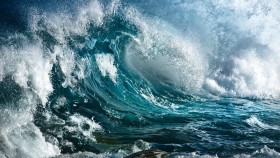Meet the PhD researcher solving a very big (but very small) molecule mystery
Tharika’s passion for her research subject is infectious. When she described her PhD topic as a “soul-burning question” in her winning Three Minute Thesis presentation, it really seemed like there was nothing in the world more important than finding an answer.
“I find it so exciting,” she says, and immediately, so do you. “It’s about finding a missing piece to the puzzle of how life emerged on Earth.”
That puzzle piece is: who made cheilanthanes? Whether it’s at field sites in the Swiss Alps, or in the lab at the ANU Research School of Earth Sciences, this is what Tharika’s soul burns to know. It’s a big question, about something very, very small.
“This is wild,” says Tharika Liyanage talking about cheilanthanes. And the thing is, you can’t help but agree – even if you don’t know what cheilanthanes are.
Tharika’s passion for her research subject is infectious. When she described her PhD topic as a “soul-burning question” in her winning Three Minute Thesis presentation, it really seemed like there was nothing in the world more important than finding an answer.
“I find it so exciting,” she says, and immediately, so do you. “It’s about finding a missing piece to the puzzle of how life emerged on Earth.”
That puzzle piece is: who made cheilanthanes? Whether it’s at field sites in the Swiss Alps, or in the lab at the ANU Research School of Earth Sciences, this is what Tharika’s soul burns to know. It’s a big question, about something very, very small.

Tharika at work in the field
Cheilanthanes are fossilised biological molecules present in almost every rock found throughout Earth’s history. Right now, there are roughly 500 billion tons of this molecule in the ground, but, Tharika says, we have no idea where they came from. Which is, indeed, wild.
“There was one idea of it being green algae, but that was called into question about ten years ago,” Tharika explains, “and so then the question was up for grabs again.”
It was assumed that whatever made cheilanthanes—their microbial source—went extinct a long time ago. But using a new technique which she invented, Tharika has found evidence that cheilanthanes are being made by an organism alive today.
Now she has even more questions, about the molecule’s function and how it relates to the bigger story of the evolution of life. Searching for answers makes her not too different from Sherlock Holmes, she says.
“It’s like the scene of a crime, with clues that you have to piece together to work out what happened. What can they tell us about how life emerged? What was there billions of years ago? What was going on?”
Curiosity about the past is exactly what attracted Tharika to Earth Sciences, she says, first in her Bachelor of Science and then her Master of Earth Sciences (Advanced), both at ANU.
“What really speaks to me about Earth Sciences is the power of being able to read our history from the rocks. When I first started studying it, I thought it was just fossils, and that was as far back as they could take you, but when I was introduced to fossilised molecules, I realised we can take the record even further back, and that’s so cool.”
Piece the past together with a Master of Earth Sciences from ANU - and shape your future career.









